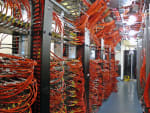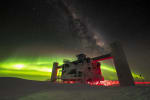It’s now bright enough to see your way around outside at the Pole, which is great. Well, maybe, depending on your perspective. Sure, now you can leave your headlamps behind as you venture outdoors. But there’s a downside…the auroras are gone, and there are very few stars left visible in the sky. With the complete […]
News
Week 34 at the Pole
Last week was a quiet one for IceCube, and the detector operated with a maximum possible weekly uptime of 99.95%. The brightening sky was beautiful as shown in the above image of the South Pole station. Station life was also reported to be quiet, but “quiet” doesn’t mean without any festivities. First up, they enjoyed […]
Week 33 at the Pole
Last week, some of the winterovers walked out to the End of the World—that’s what they call the area that extends beyond the storage berms out on the ice—to take some photographs of the setting moon. It was bitterly cold, so they couldn’t use their cameras for long, but they did get in a few […]
Week 32 at the Pole
Some weeks at the Pole are busier than others, and last week was one of the busy ones. IceCube winterovers made not one but two trips out to the IceCube Lab. The first trip was planned and entailed replacing a hard drive while also fitting in some inclinometer measurements while they were out there. The […]
Week 31 at the Pole
It’s getting obviously lighter outside, but thanks to clear skies (and intrepid winterover-photographers), we are still being treated to some wonderful images of the stars and auroras over the South Pole landscape. Above is the ceremonial pole as the sun rises behind the flags. After taking this photo, winterover Martin turned around to photograph the […]
Week 30 at the Pole
Lots of fun was being had last week at the Pole. First up, there was a trivia night paired with a burger bar, which definitely wasn’t offering standard fare. IceCube winterover Josh ordered up the “Mountain of madness.” Then there was Josh’s dishpit assignment, not normally an event one looks forward to but which was […]
10 years of IceCube data now publicly available at NASA’s HEASARC archive
The IceCube Collaboration has teamed up with NASA’s High-Energy Astrophysics Science Archive Research Center (HEASARC) to share 10 years of IceCube data with the public. Supported by the Astrophysics Division of NASA’s Science Mission Directorate and a service of the Astrophysics Science Division at NASA’s Goddard Space Flight Center (GSFC), the HEASARC is the primary […]
Week 29 at the Pole
Last week was the annual Polympics—just like the real Olympics, only … very different. At the South Pole, they compete in nonstandard events, where sometimes the rules are arbitrary and people argue about them. (It adds to the fun!) This year, there was the traditional sled pull, in which three team members pull a fourth […]
New machine learning method dramatically improves IceCube data processing
Machine learning has arrived at the South Pole. Well, not literally, but machine learning is now being applied to data collected at the South Pole by the IceCube Neutrino Observatory, an unconventional telescope made up of thousands of sensors buried in ice. IceCube’s goal is to detect tiny, nearly massless particles called neutrinos that fly […]
Week 28 at the Pole
Lighter days are coming, but last week there were still opportunities to take pictures outside in total darkness, and IceCube winterover Martin cashed in. Check out these great images he captured at the IceCube Lab (ICL). Above is the ICL, backlit by a strong auroras and angled almost as if pointing up toward the clearly […]









